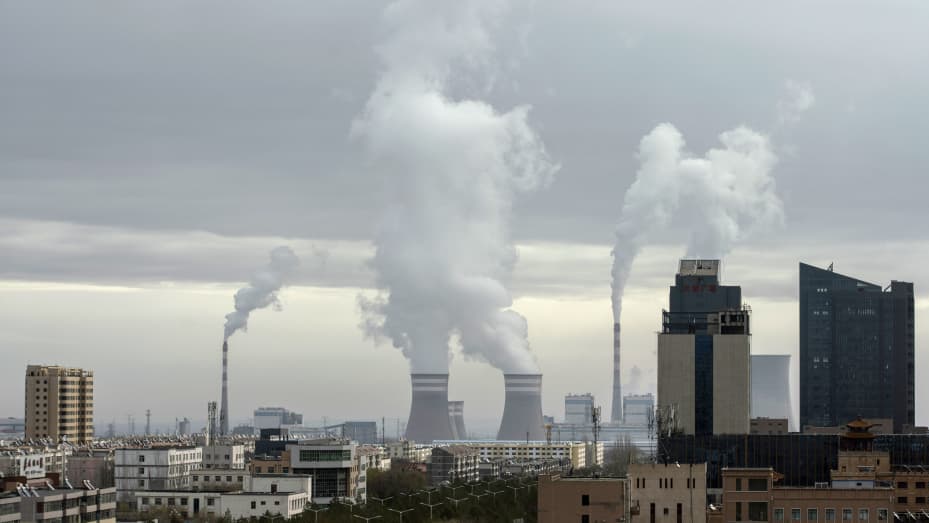PUBLISHED WED, OCT 6 2021
Catherine Clifford@IN/CATCLIFFORD/@CATCLIFFORD
“Absent significant changes in policy or technology,” global energy consumption will grow by almost 50% between 2020 and 2050, according to a new report released Wednesday from the U.S. Energy Information Administration.
Energy-related carbon dioxide emissions will also increase through 2050 due to economic and population growth, the report finds.
The number of internal combustion engine cars is expected to peak in 2023 in Organization for Economic Cooperation and Development (OECD) countries. Globally, the internal combustion engine market is expected to peak in 2038.

A coal fired power plant in Jiayuguan, Gansu province, China.
Qilai Shen | Bloomberg | Getty Images
Even with the current drive toward more renewable energy sources, global carbon emissions are going to increase through 2050, unless there are significant changes in policy or technology between now and then.
That’s according to a new report released Wednesday from the U.S. Energy Information Administration, a division of the federal U.S. Department of Energy which analyzes and shares data. For the report, the EIA projects future energy trends based on current laws and regulations. This assumption, and the resulting findings, emphasize the need for governmental changes and new technology to reduce the carbon dioxide emissions that cause climate change.
“Even with growth in renewable energy, without significant policy changes or technological breakthroughs, we project increasing energy-related carbon dioxide emissions through 2050,” said Stephen Nalley, the Acting Administrator of the EIA, in a written statement.
Assuming current trajectories, economic and population growth will drive a 50% increase in global energy consumption between 2020 and 2050.
“The worldwide push to generate more electricity from renewables and also increase electric grid reliability could push more expansion of battery storage on a global scale,” Nalley said.
But even though renewables will grow fastest, liquid fuels will be the still be the primary source of energy, primarily because of the transportation and industrial sectors. (Liquid fuels refers to all petroleum, including crude oil and products of petroleum refining, natural gas liquids, biofuels, and liquids derived from other hydrocarbon sources, including coal to liquids and gas to liquids. Here, liquid fuels does not include liquefied natural gas and liquid hydrogen.)
Oil and natural gas production will increase overall to meet demand in developing economies in Asia.
“The fast-growing economies in Asia could combine to become the largest importer of natural gas and crude oil by 2050, given their significant increase in energy consumption,” Nalley said.
Demand for and consumption of energy in non-OECD countries in Asia will be more than those countries are able to produce. That will drive an increase in the import of crude oil and finished petroleum products from the Middle East, the EIA says.
Non-OECD countries in Asia will be the largest importers of natural gas, the report says, while Russia will be the largest exporter of natural gas.
Also mentioned in the report, sales of electric vehicles are expected to grow through 2050, and the number of internal combustion engine cars is expected to peak in 2023 in OECD countries.
EIA projects nearly 50% increase in world energy use by 2050, led by growth in renewables

Note: Petroleum and other liquids includes biofuels.
In our International Energy Outlook 2021 (IEO2021) Reference case, we project that, absent significant changes in policy or technology, global energy consumption will increase nearly 50% over the next 30 years. Although petroleum and other liquid fuels will remain the world’s largest energy source in 2050, renewable energy sources, which include solar and wind, will grow to nearly the same level.

Falling technology costs and government policies that provide incentives for renewables will lead to the growth of renewable electricity generation to meet growing electricity demand. As a result, renewables will be the fastest-growing energy source for both OECD and non-OECD countries. We project that coal and nuclear use will decrease in OECD countries, although the decrease will be more than offset by increased coal and nuclear use in non-OECD countries.
We project that global use of petroleum and other liquids will return to pre-pandemic (2019) levels by 2023, driven entirely by growth in non-OECD energy consumption. We do not project OECD liquid fuel use to return to pre-pandemic levels at any point in the next 30 years, in part because of increased fuel efficiency.

Note: Delivered consumption includes fuels directly used by the end-use sectors as well as electricity, excluding generation, transmission, and distribution losses.
We project that the industrial sector will increasingly consume petroleum liquids as feedstock in the expanding chemicals industry. In OECD countries, liquid fuel consumption in the industrial sector will grow three times as fast as liquid fuel consumption in the transportation sector.
Delivered electricity consumption will grow the most in the residential end-use sector. We project that in non-OECD countries, electricity will account for more than half of the energy used in households by 2050, compared with 33% in 2020. In non-OECD commercial buildings, we project that electricity will make up an even larger share of energy consumption in 2050, at 64%.
Globally, we project increased consumption of natural gas through 2050. The industrial sector is the main contributor to the growth in global natural gas consumption through 2050 in our Reference case, largely in non-OECD countries. Across OECD countries, gains in energy efficiency will reduce household natural gas use by 2050. The industrial sector will use the largest share of both natural gas and coal among all end-use sectors. Industrial coal use will expand fastest in non-OECD countries, where energy-intensive industries such as iron and steel production are expanding more quickly than in OECD countries.
Principal contributor: Courtney Sourmehi

No comments:
Post a Comment